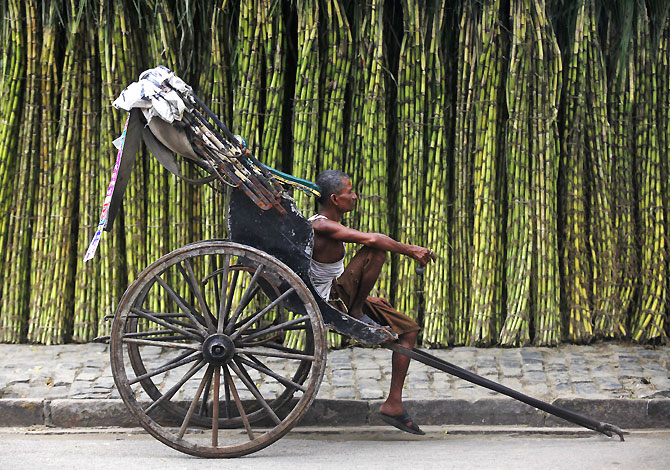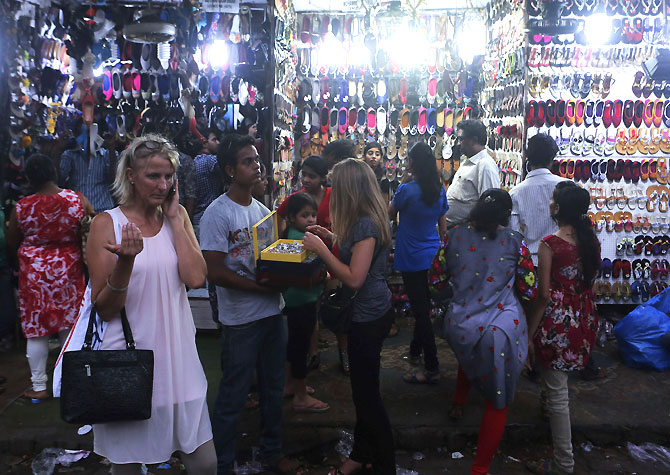 | « Back to article | Print this article |
It's the GDP, stupid
‘India should exit Hubristan and stop patting itself on its back for 5 years of rapid growth, and all the Rolls Royces, BMWs and private jets owned by its billionaires, and instead focus on the urgently needed reforms to get GDP growth back in the 7 to 8 pc range and higher,’ says Ram Kelkar.
Rahm Emanuel, Chicago’s mayor, is famously quoted as saying that ‘… you never let a serious crisis go to waste … it's an opportunity to do things you think you could not do before.’
Yet instead of using the crisis to get the nation and the leadership to do serious introspection and build consensus for fundamental changes in economic policy, Prime Minister Manmohan Singh blamed ‘global unrest and a huge current account deficit’ for the fall of the Indian rupee.
Channeling United States Senator John McCain’s quote exactly five years ago after the Lehman meltdown which led to the global financial crisis, Dr Singh added that ‘… it is important to recognise that the fundamentals of the Indian economy continue to be strong.’
Dr Raghuram Rajan, the newly appointed RBI Governor, is getting credit for jawboning the Rupee back and taking some immediate steps including opening a window for banks to swap new FCNR deposits and enhancing the borrowing capacity of banks.
Nevertheless, Dr Rajan is unlikely to fight the natural trend for the rupee, since experts view the fair value to be around Rs 60 to the US dollar given India’s higher inflation rate and lower productivity growth over the past few years.
With all the focus on the rupee, what is being missed is the old dictum that ‘it’s the economy, stupid.’
The real crisis India faces is not the fall of the rupee, which could partially help revive the export economy, but instead the flagging growth rate.
Since peaking at over 9 per cent in late 2010 and early 2011, India's Real GDP growth has tapered down monotonically into the 4 per cent to 5 per cent range over the past several years.
It's time for Indian leaders to leave their hubris behind, stop declaring victory prematurely, and refrain from proclaiming that India could ‘grow in its sleep’ as some did at a recent World Economic Forum according to the Economist. The hard work of becoming a global power has barely begun.
The fact that Harper’s Bazaar, Rolls-Royce and BMW are doing well in India is all wonderful, but symptomatic of a nation where the total wealth of its billionaires is almost 10 per cent of the national GDP, down from 22 per cent at the peak just prior to the global financial crisis.
Please click on NEXT to read further...
It's the GDP, stupid
Meanwhile, a slowing economy could be perilous in a nation with a burgeoning population of young people looking for jobs and opportunity. In an era of globalisation with television and other media outlets providing unprecedented exposure to the outside world, people from the smallest towns are well aware of the quality of life and progress in nations across the globe.
If the common man does not see continuing improvement in quality of life after decades of rapid growth and happy talk of Shining India, there could be serious consequences.
In the heyday of BRICS euphoria, the conventional wisdom was that India was on an inevitable growth path, underpinned by demographics and a high rate of savings. Now the cynics will note that India’s GDP growth rate is reverting back to a 6% long-term average since the mid-1980s, with a blip of rapid growth in the 2004 to 2007 period.
India needs 12 million to 13 million new jobs each year just to keep up with the new entrants into the workforce for the next decade or so. Not enough jobs will be created if India expands at a 6% growth rate and the demographic dividend may turn into a time bomb.
For all the comparisons made between China and India, the truth of the matter is that the long-term average growth rate of India has consistently been 1 pc to 2 pc below the average GDP growth rate for China, which is already showing signs of getting back on the growth track.
Underlying the growth gap is the fact that India has been following a track that is very different from other Asian countries such as Japan, Korea and China, which started by exporting products like garments and toys made by large numbers of minimum wage workers, before moving to more advanced products and eventually focusing on the service sector.
The abysmal state of India’s road network, power infrastructure and restrictive labour laws have discouraged companies from setting up manufacturing plants that could employ large numbers of workers.
Instead, Indian exports are focused on IT exports and some higher-value goods and services such as auto parts and robotics that create fewer jobs mainly for workers with advanced skills.
India has thus largely skipped the traditional first step and gone straight to services and some degree of capital-intensive manufacturing that requires skilled workers.
Meanwhile, exports of textiles and agricultural products which can support large numbers of jobs account for less than 20% of Indian exports, and India now exports fewer garments than Bangladesh.
TCS, Infosys, Cognizant and other IT majors are likely to benefit from the decline of the Rupee but growth opportunities are getting fewer as wage differentials narrow between India and the West especially for hi-tech workers. However, India has the distinction of having the highest wage increase of 10.5 pc in 2012, though inflation offset this somewhat. And an under-trained and under-educated workforce with unrealistic wage growth expectations and a predilection for job-hopping is likely to make these companies less competitive over time.
Please click on NEXT to read further...
It's the GDP, stupid
Which brings us to the Sen versus Bhagwati debate over the path that India must take to get back on the growth path. Nobel Laureate Dr Amartya Sen posits that ‘… the far greater gap between India and China is in the provision of essential public services -- a failing that depresses living standards and is a persistent drag on growth.’
He points out that inequality is high in both countries, but China has done far more than India to raise life expectancy, expand general education and secure health-care for its people. And he concludes that if India is to catch up with China in manufacturing capacity and create the jobs needed to grow the economy, it needs a better-educated and healthier labor force at all levels of society.
Jagdish Bhagwati meanwhile has challenged Amartya Sen in public, calling him out as a statist and socialist, and he believes that it is a focus on economic growth that will improve the lives of poor Indians, rather than a return to redistributive socialist policies.
In a book co-authored with Dr Arvind Panagariya, Dr Bhagwati argues for both intensifying and broadening the growth-inducing reforms which he calls Track I reforms and deferring more redistributive programs for health, education and public distribution systems to Track II.
The Sen versus Bhagwati debate has been blown out of proportion by the media which loves a Crossfire-like confrontation, with the added masala of a Narendra Modi versus Rahul Gandhi and BJP versus Congress angle added for good measure.
The choice between rapid economic growth on the one hand and education and poverty reduction on the other is a false choice. Workers who are educated and healthy enough to be capable of being productive are essential to manufacturing sector growth. And a strong economy with a robust manufacturing sector will lead to jobs and poverty reduction.
The Congress party-led coalition led by Dr Manmohan Singh, who ushered in the unshackling of the Indian economy in the 1990s, became timid and complacent after taking some steps that were bold in the context of India’s Nehruvian socialist path. But their zeal and appetite for reform dwindled, and in recent years, the party has begun to once again focus on quasi-socialist policies such as income guarantee schemes instead of focusing on fundamental structural issues.
India can no longer rely on call centres, software outsourcing and back office services for health insurers and law firms, and urgently needs a manufacturing model to provide jobs and opportunities for the large numbers of unskilled labourers entering the marketplace.
India employs only about 50 million workers in manufacturing which is a surprising statistic for a nation with a population of over a billion, and 245 million Indian citizens work in agriculture.
The transition from a primarily agricultural economy to at the very least a mixed manufacturing-agricultural paradigm is the only way India can pull the hundreds of millions who still live in poverty. And lest this be viewed as an unrealistic goal, it is useful to note that 41% of the US workforce was employed in agriculture in 1900 and that number has now come down to 1.9% as of 2002.
Building a manufacturing sector to recharge the Indian economy will not be easy, and this is where Dr Bhagwati’s prescription seems most appropriate, whereas Dr Sen’s focus seems to be on matters which can take the back seat to the urgent prerogative of growth.
Dr Bhagwati’s Track I reform ideas are not exactly new, and call for a focus on infrastructure, education, labor laws, and land acquisition amongst others. Similar ideas have been floated by others, including the Confederation of Indian Industry’s 10-point plan announced in 2012, which includes other key and necessary reforms such as transparent and consistent taxes and regulations, power sector investments, and ways to strengthen manufacturing sector competitiveness.
When Dr Raghuram Rajan was still at the IMF, he had written an insightful analysis about India titled India: The Past in its Future, in which he recalls the story of the devas and asuras churning the ocean of milk, which first gave out poison but eventually yielded the divine nectar, amrita. He concluded by saying that ‘limitless optimism is justified, but hard work and churning lie ahead.’
India should exit Hubristan and stop patting itself on its back for 5 years of rapid growth, and all the Rolls Royces, BMWs and private jets owned by its plethora of billionaires, and instead focus on the urgently needed reforms to get GDP growth back in the 7 to 8% range and higher.
The Rupee Crisis should become a wake-up call for India to get basic reforms done in a bi-partisan way. Sadly, the prospects of such a denouement look dim considering that Finance Minister P Chidambaram’s appeal for reforms based on a 10-point agenda for growth, for which he called for bipartisan support, was promptly criticized by BJP leader Yashwant Sinha.
The current ruling coalition and the Opposition better wake up to the realities of a slowing India, and act now, lest the demographic boon becomes India’s demographic bomb.
Ram Kelkar is a Chicago-based writer.


